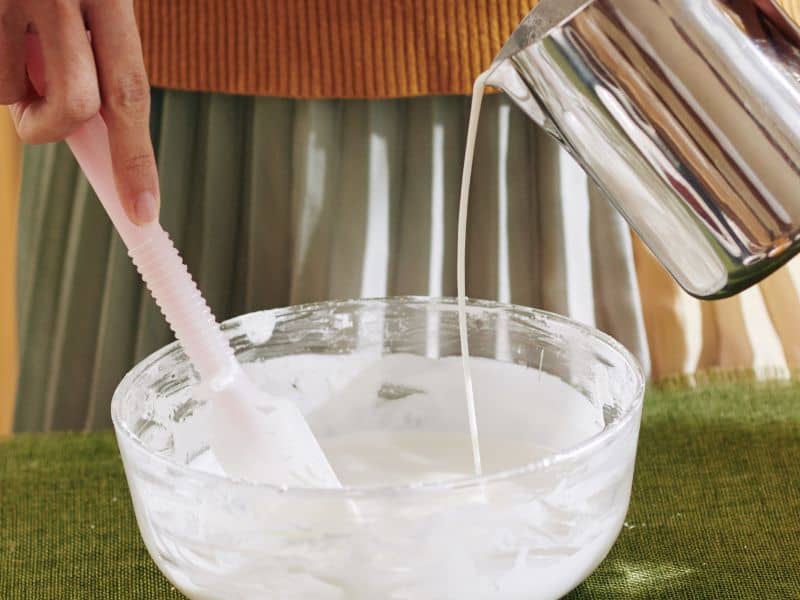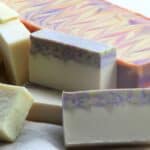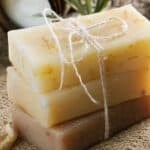If you are new to soap making, candle making and similar crafts then you may be surprised how much of a role temperature plays in nearly all aspects of these crafts. Temperature plays a critical role in the soap making process, and getting it right can make all the difference in the final product. Let’s take a look at why temperature is so important for cold process soap making.
The ideal temperature range for making cold process soap is 100°F to 130°F (38°C to 54°C) for both oils and lye solution. This ensures a controlled saponification process, giving you ample time to mix, pour, and design your soap before it hardens.
When soap makers talk about temperature, it is important to consider that the temperature of all your ingredients should be in this range.
This includes oils and lye solution as well as any additives like colorants, fragrances, etc. You can warm or cool your ingredients accordingly to get them all within the right range before mixing.
It is important to warm the oils and other ingredients because some can harden at or near room temperature and you do not want your oils hardening before the saponification process can take place. Let’s take a closer look at saponification and the importance of temperature.
The Role of Temperature in Saponification
Saponification is the chemical reaction that turns oils and lye into soap. In simple terms, it’s the process where fatty acids from oils react with an alkali (usually sodium hydroxide, or lye) to form soap and glycerin.
This reaction is essential in cold process soap making, and the temperature plays a crucial role in ensuring success.
The role of temperature in saponification is vital for several reasons. First, temperature affects how fast the reaction occurs. If it’s too low, the reaction may be too slow, and the soap mixture may harden before saponification is complete.
On the other hand, if the temperature is too high, the reaction may occur too quickly, making it difficult to manage and potentially causing issues like soap separation. Striking the right balance is essential for a smooth and successful soap-making experience.
The Importance of Cold Process Soap Temperature Control
The ideal temperature range for cold process soap making is between 100°F and 130°F (38°C and 54°C) for both oils and lye solution. This range ensures a controlled saponification process, giving you enough time to mix, pour, and design your soap before it hardens.
Here are some tips for maintaining the right temperature:
- Use a thermometer: Accurately measure the temperature of your oils and lye solution using a reliable thermometer, like a digital or infrared one.
- Heat oils gently: Melt solid oils and fats over low heat, then combine with liquid oils. This helps achieve the desired temperature without overheating.
- Cool lye solution: After mixing lye with water, allow it to cool down to the target temperature before combining it with the oils.
- Monitor and adjust: Keep an eye on the temperature during the mixing process. If needed, use a heat source or a cold water bath to maintain the desired range.
- By understanding the importance of temperature in saponification and maintaining the ideal temperature range, you’ll be well on your way to creating beautiful, high-quality cold process soaps.
Tools and Equipment for Temperature Control
Having the right tools and equipment can make temperature control in cold process soap making much easier.
Here are some essentials:
- Thermometers: Accurate temperature measurements are crucial. Digital or infrared thermometers are recommended, as they offer quick and precise readings.
- Double boiler: This is a handy tool for melting solid oils gently and evenly. Place the oil-filled container inside a larger pot filled with water, then heat the water to melt the oils.
- Heating pad or crockpot: These devices can help maintain the temperature of your soap mixture during the mixing and pouring process. They’re especially useful if you’re working in a cold environment.
- Insulated containers: Using insulated containers for mixing and pouring can help retain heat and maintain a consistent temperature throughout the process.
Choosing the Right Oils
Different oils have unique properties that can impact the temperature during cold process soap making.
Here are some factors to consider when selecting oils:
- Melting point: Oils with a high melting point, like coconut oil or palm oil, require more heat to melt. Conversely, oils with a low melting point, like olive oil or sunflower oil, are liquid at room temperature.
- Saponification value: The saponification value refers to the amount of lye needed to saponify a specific oil. Oils with higher saponification values may react more quickly, potentially affecting the temperature.
- Fatty acid profile: The fatty acid composition of an oil can influence how it behaves during saponification. For example, oils rich in lauric or myristic acids can cause a soap mixture to thicken more quickly.
Some recommended oils for cold process soap making include:
- Olive oil: A popular choice due to its gentle, moisturizing properties and relatively low melting point.
- Coconut oil: Provides a rich lather and contributes to the hardness of the soap. Remember to melt it gently before mixing.
- Palm oil: Also adds hardness and lather to the soap. Look for sustainably-sourced palm oil to minimize environmental impact.
- Sunflower oil: High in linoleic acid, this oil is lightweight and moisturizing, making it a good choice for those with sensitive skin.
- Experimenting with different oils and combinations can help you find the perfect blend for your cold process soaps while maintaining the ideal temperature throughout the process.
Troubleshooting Temperature Issues
Temperature-related problems can sometimes arise in cold process soap making.
Here are some common issues and solutions to prevent and fix them:
- Soap mixture hardening too quickly: This can occur if the temperature is too low or if it drops suddenly. To prevent this, ensure that your oils and lye solution are within the ideal temperature range and maintain a consistent temperature during mixing.
- Soap separation: High temperatures can cause oils and lye solution to separate. To avoid this, keep an eye on the thermometer and try not to exceed the recommended temperature range. If separation occurs, try stirring the mixture gently to recombine the ingredients.
- Partial gel phase: This happens when the soap mixture doesn’t heat uniformly during saponification, resulting in a partially gelled soap with a different texture in the center. To prevent this, insulate your soap mold with towels or a blanket and maintain a consistent temperature.
- Cracked or overheated soap: Overheating can cause soap to crack or develop a strange texture. If this happens, uncover the soap and allow it to cool. To prevent overheating, monitor the temperature closely and avoid insulating your soap mold if your recipe is prone to overheating.
Benefits of Proper Temperature Control
Maintaining the correct temperature during cold process soap making offers several benefits:
- Consistent soap quality: Proper temperature control helps ensure that your soap has a uniform texture, appearance, and performance. This is especially important if you’re selling your soap or gifting it to friends and family.
- Easier soap making process: When the temperature is just right, the soap mixture is easier to work with, allowing you to mix, pour, and create designs without rushing or worrying about the soap hardening too soon.
- Reduced risk of issues: By keeping the temperature within the ideal range, you minimize the chances of encountering problems like separation, partial gel phase, or cracking. This saves you time, effort, and resources in the long run.
- In conclusion, understanding the importance of temperature in cold process soap making and learning how to control it will lead to better-quality soaps and a more enjoyable soap making experience.
Frequently Asked Questions
While a microwave can be used to melt solid oils, it may heat them unevenly or too quickly. A double boiler is recommended for more gentle and even heating.
Yes, it is safe to make cold process soap at home if you follow proper safety guidelines, such as wearing protective gear, working in a well-ventilated area, and handling lye with caution.
To prevent a partial gel phase, insulate your soap mold with towels or a blanket and maintain a consistent temperature during the saponification process.
Ensure that your oils and lye solution are within the ideal temperature range and maintain a consistent temperature during mixing to prevent the soap mixture from hardening too soon.
Consider factors such as melting point, saponification value, and fatty acid profile when selecting oils for your soap. These properties can affect the temperature and overall quality of your soap.
Conclusion
In conclusion, mastering temperature control in cold process soap making is essential for creating beautiful, high-quality soaps. By understanding the importance of temperature in saponification and following the tips and guidelines shared in this article, you’ll be well-prepared to tackle any temperature-related challenges.
As you continue on your soap-making journey, remember to experiment with different oils, techniques, and equipment to find what works best for you. With patience, practice, and a keen eye on the temperature, you’ll soon be crafting stunning soaps that you can be proud of.






